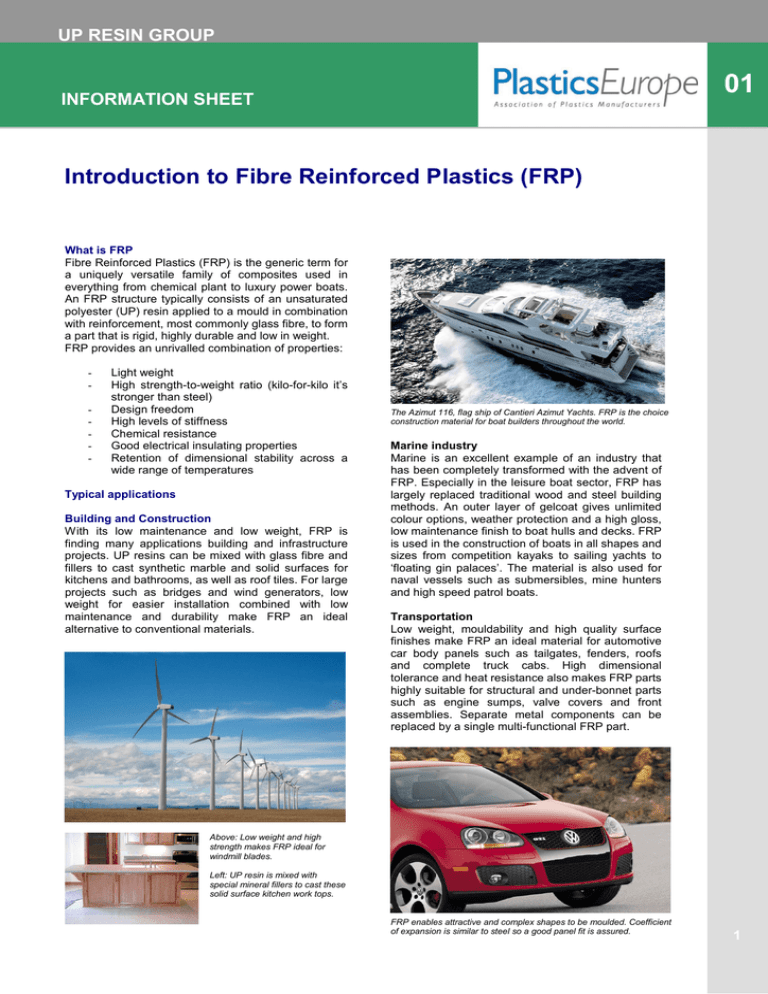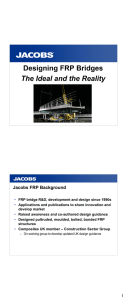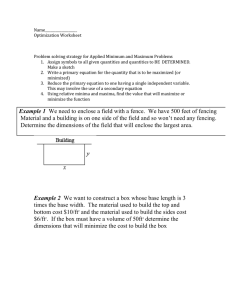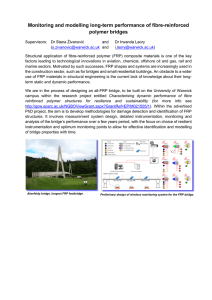Introduction to Fibre Reinforced Plastics (FRP)
advertisement

UP RESIN GROUP 01 INFORMATION SHEET Introduction to Fibre Reinforced Plastics (FRP) What is FRP Fibre Reinforced Plastics (FRP) is the generic term for a uniquely versatile family of composites used in everything from chemical plant to luxury power boats. An FRP structure typically consists of an unsaturated polyester (UP) resin applied to a mould in combination with reinforcement, most commonly glass fibre, to form a part that is rigid, highly durable and low in weight. FRP provides an unrivalled combination of properties: - Light weight High strength-to-weight ratio (kilo-for-kilo it’s stronger than steel) Design freedom High levels of stiffness Chemical resistance Good electrical insulating properties Retention of dimensional stability across a wide range of temperatures Typical applications Building and Construction With its low maintenance and low weight, FRP is finding many applications building and infrastructure projects. UP resins can be mixed with glass fibre and fillers to cast synthetic marble and solid surfaces for kitchens and bathrooms, as well as roof tiles. For large projects such as bridges and wind generators, low weight for easier installation combined with low maintenance and durability make FRP an ideal alternative to conventional materials. The Azimut 116, flag ship of Cantieri Azimut Yachts. FRP is the choice construction material for boat builders throughout the world. Marine industry Marine is an excellent example of an industry that has been completely transformed with the advent of FRP. Especially in the leisure boat sector, FRP has largely replaced traditional wood and steel building methods. An outer layer of gelcoat gives unlimited colour options, weather protection and a high gloss, low maintenance finish to boat hulls and decks. FRP is used in the construction of boats in all shapes and sizes from competition kayaks to sailing yachts to ‘floating gin palaces’. The material is also used for naval vessels such as submersibles, mine hunters and high speed patrol boats. Transportation Low weight, mouldability and high quality surface finishes make FRP an ideal material for automotive car body panels such as tailgates, fenders, roofs and complete truck cabs. High dimensional tolerance and heat resistance also makes FRP parts highly suitable for structural and under-bonnet parts such as engine sumps, valve covers and front assemblies. Separate metal components can be replaced by a single multi-functional FRP part. Above: Low weight and high strength makes FRP ideal for windmill blades. Left: UP resin is mixed with special mineral fillers to cast these solid surface kitchen work tops. FRP enables attractive and complex shapes to be moulded. Coefficient of expansion is similar to steel so a good panel fit is assured. 1 01 INFORMATION SHEET (continued) Special grades of UP resins are available that give high levels of fire retardancy and low smoke emission. These are important requirements for public transport applications, especially in trains and in-tunnel applications like cladding and seating. FRP with its good electrical insulating properties and flame retardance Is ideal for modern rail applications such as insulators, arc barriers Interior fittings and seating. A brief history of FRP Early man was aware of the basic principle that a composite material is greater than the sum of its parts. For example clay and straw were found to be stronger than clay alone; straw being the fibrous reinforcement and clay being the matrix. The first use of glass fibre reinforced polyester composites was in the aircraft industry during the 1940s. This was followed some years later by the first non-military application in the marine sector, where FRP proved a complete innovation – revolutionising the way boats were built. FRP Process In the open moulding process, gelcoat, resin and glass fibre are applied by brush or spray onto a mould, building up successive layers to form a laminate. The process has also been highly industrialised through closed moulding techniques such as resin transfer moulding, pultrusion and SMC - a pre-compounded material favoured for higher volume parts like car and truck body panels. Chemical plant and pipes With its excellent resistance to corrosion and chemical attack, FRP is widely used in the chemical industry for the construction of pipe work and for chemical storage vessels, fume scrubbers and many other high performance applications. Vinyl ester and epoxy vinyl ester resins have been developed to give high levels of chemical resistance even in the most aggressive environments. Gelcoat being spray-applied to an open mould surface. The future FRP is continually finding new applications throughout industry. Developments and innovations in resin technology will ensure an exciting and dynamic future for FRP composites as a highly versatile and costeffective alternative to traditional materials like metals, concrete and wood. This publication is intended for guidance only and while the information is provided in good faith and has been based on the best information currently available, is to be relied upon at the user’s own risk. The information contained in this document is provided in good faith and, while it is accurate as far as the authors are aware, no representations or warranties are made with regards to its completeness and no liability will be accepted for damages of any nature whatsoever resulting from the use of or reliance on the information contained in the publication. Vinyl ester based FRP was used for the inner lining of this 178m high chimney in a flu gas desulphurisation plant. PlasticsEurope Avenue E. van Nieuwenhuyse 4 B-1160 Brussels, Belgium Telephone + 32 2 676 1732 Fax +32 2 675 3935 Email info@plasticseurope.org www.plasticseurope.org 2






